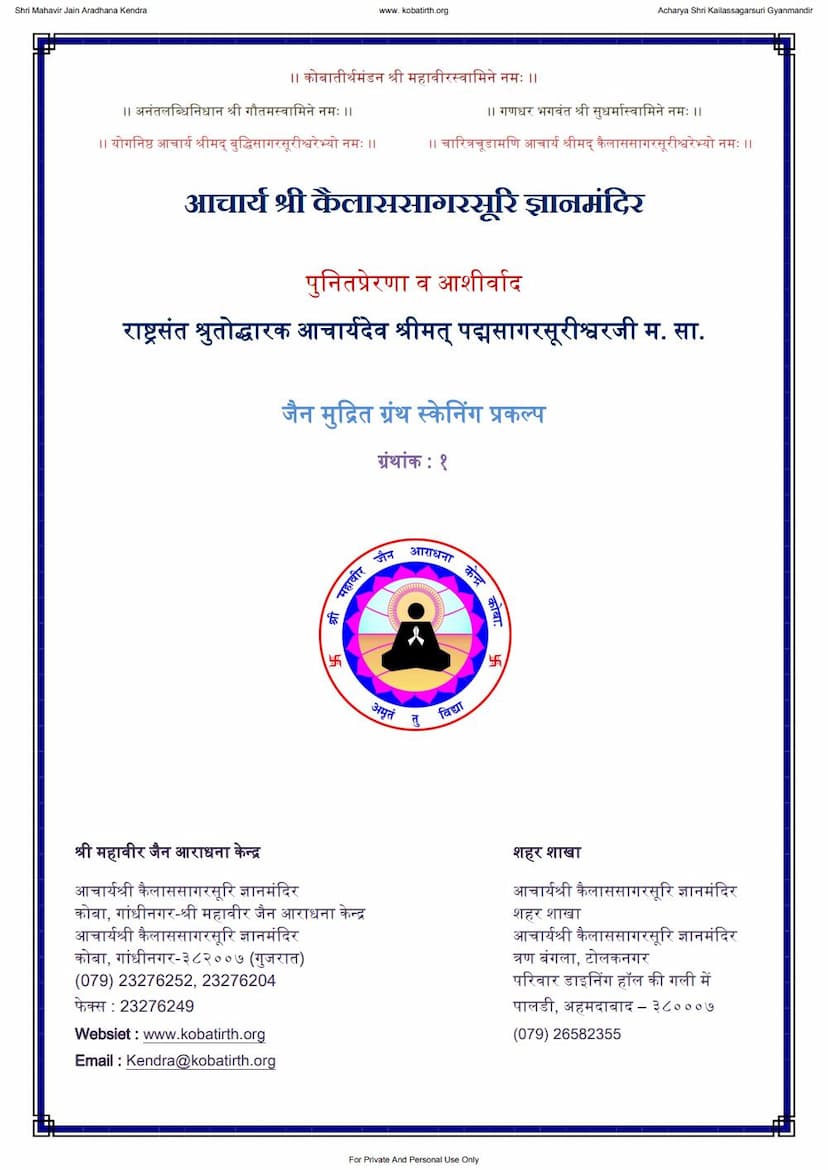Katyayanas Sarvanvkramani Of Rigveda
Added to library: September 2, 2025

Summary
Here's a comprehensive summary of the Jain text provided, focusing on the key information presented in the preface and the beginning of the text itself:
Book Title: Katyayanas Sarvanvkramani of Rigveda Author(s): A A Macdonell Publisher: Clarendon Press Year: 1886
Overall Summary:
This volume, edited by A. A. Macdonell and published by Clarendon Press in 1886, presents a critical edition of Kâtyâyana's Sarvânukramanî of the Rigveda. This seminal work is a comprehensive index of the Rigveda, meticulously cataloging each hymn of the Rigveda, including:
- Pratîka (first word/words of the hymn): A crucial identifier for each hymn.
- Number of Verses: The precise count of verses within each hymn.
- Name of the Poet (Rishi): The traditional author attributed to the hymn.
- Name of the Deity (Devatâ): The primary deity invoked in the hymn.
- Metres (Chanda): The specific metrical structure of the hymn, or its various parts.
The edition also includes extracts from Shadgurusishya's commentary, titled Vedârthadîpikâ. This commentary is highly significant as it provides invaluable insights into the understanding and interpretation of the Sarvânukramanî from a later period (around 1187 CE). Shadgurusishya's work details the context, mythology, and grammatical nuances associated with the hymns and their indices.
Key Content and Contributions of the Volume:
-
Kâtyâyana's Sarvânukramanî: The core text, meticulously edited with critical notes. It follows the Sakala recension of the Rigveda. The preface indicates that the Sarvânukramanî itself is a compilation and condensation of earlier index works, attributed to Saunaka and others, making it a comprehensive overview of the Rigveda's structure.
-
Shadgurusishya's Vedârthadîpikâ: This commentary is extensively utilized. Macdonell highlights its importance for understanding the text as it was known and interpreted in the 12th century CE. The commentary includes:
- Itihâsas (narratives/stories): Often quoted from the Brihaddevatâ, these provide mythological and historical context.
- Grammatical explanations: Particularly on unusual or difficult forms and constructions.
- Discussions on diction and metre: Shedding light on the linguistic and metrical aspects of the Rigveda.
- Tributes to teachers: Shadgurusishya lists the seven works he was specially instructed in by his six teachers, demonstrating a rich lineage of Vedic scholarship.
-
Other Related Texts: The preface discusses related anukramani literature, including:
- Saunaka's works: Årshanukramani, Khando-nukramani, Devatânukramani, and Suktânukramani. Macdonell details the known manuscripts and contents of these, noting the challenges in accessing or verifying them.
- Brihaddevatâ: Described as a work that is "practically one" with the anukramani literature, despite not being called one.
- Pâdânukramani (also Pâdavidhâna): Another index attributed to Saunaka, focusing on pada-level analysis.
-
Historical Context of Anukramanîs: Macdonell places the development of anukramanîs as a literary genre several centuries before the Common Era, citing Apastamba's Dharma Sutra as an early reference to the Anuvâkânukramani. He suggests that many of these indices, including the Anuvâkânukramanî, were likely composed by Saunaka, the author of the Rigveda Prâtisâkhya. Kâtyâyana's Sarvânukramanî, likely composed around the mid-4th century BCE, is seen as a comprehensive work building upon these earlier efforts.
-
Editorial Apparatus: The volume is rich in critical apparatus, including:
- Critical Notes: Providing details on manuscript variations and textual issues.
- Appendices: These are extensive and include:
- Explanatory Notes.
- Index of Pratîkas.
- Index of Metres.
- List of Rigvedic Verses quoted as examples.
- List of Authors and Works quoted by Shadgurusishya.
- List of Itihasas related by Shadgurusishya.
- Index of Words.
- Corrections (Corrigenda): Indicating errata in the printed text.
-
Textual Analysis of the Sarvânukramanî: The preface delves into the structure of the Sarvânukramanî, describing its introduction (paribhashas, treatise on metres) and the main body which indexes hymns by pratîka, verse count, poet, deity, and metre. It also notes the editorial decisions made regarding readings, prioritizing Shadgurusishya's authority to ascertain the 12th-century text.
-
The Anuvâkânukramanî: This is also included in the edition, with its text and Shadgurusishya's commentary. It is described as being composed in verse, partly trishtubh and partly anushtubh, providing a detailed index of anuvâkas (sections of hymns).
-
The Khandahsankhyâ: A short index supplementing the Khando-nukramanî, providing totals for each metre across the entire Rigveda.
-
The Vedârthadîpikâ: The commentary by Shadgurusishya is presented in full, albeit with omissions for conciseness (e.g., fuller pratîkas, commonplace grammatical remarks). Macdonell emphasizes retaining matter of importance and interest.
-
Ph. D. Dissertation: Macdonell notes that the printed text of the Sarvânukramanî, with an introduction and autobiography, was his dissertation for the Ph. D. degree at the University of Leipzig in 1884.
In essence, this volume is a monumental scholarly work that provides not only the text of a crucial Rigvedic index but also a window into the history of Vedic studies and textual interpretation through the commentary of Shadgurusishya. It is a foundational resource for anyone studying the structure, authorship, and metrical system of the Rigveda.